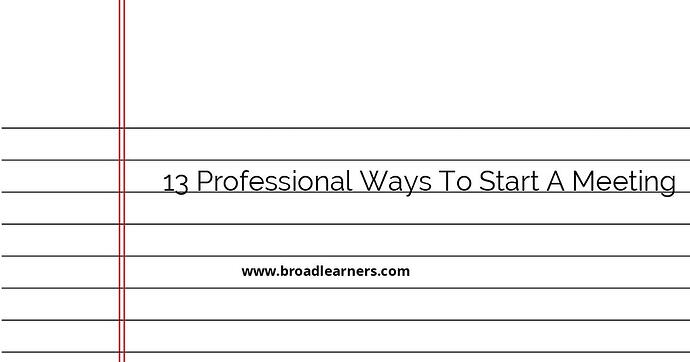Starting a meeting on the right note is crucial for setting the tone and creating a positive and productive atmosphere. Here are 13 professional ways to start a meeting:
- Begin with a warm greeting and introduction: A simple "Good morning" or "Hello everyone" followed by your name is a common and polite way to start a meeting. This helps in creating a friendly and welcoming environment.
- State the purpose of the meeting: Clearly communicate why the meeting is being held. This helps in aligning everyone's expectations and focusing the discussion on the intended topic.
- Review the agenda: Provide a brief overview of the meeting agenda, highlighting the main points or topics to be discussed. This helps in keeping the meeting organized and structured.
- Set the ground rules: Establishing ground rules such as speaking order, time limits, and respectful behavior ensures that the meeting runs smoothly and everyone's contributions are valued.
- Recognize achievements: Take a moment to acknowledge any recent achievements or milestones that team members have accomplished. This fosters motivation and encourages a positive attitude.
- Encourage participation: Create an inclusive environment by inviting everyone to share their thoughts and ideas. Encourage active participation from all attendees to foster collaboration and engagement.
- Provide context: If necessary, provide some background information or context related to the meeting topic. This helps in ensuring that everyone is on the same page and can contribute effectively.
- Share relevant updates: If there are any updates or important information that the team should be aware of, this is the time to share it. Keep the updates concise and relevant to the meeting's purpose.
- Introduce new team members: If there are new members in the meeting, take a moment to introduce them and provide a brief overview of their roles and responsibilities. This helps in making everyone feel included and informed.
- Clarify expectations: Clearly communicate the desired outcomes or objectives of the meeting. This helps in guiding the discussion and ensuring that everyone is working towards a common goal.
- Review action items from the previous meeting: If this is a recurring meeting, briefly revisit any action items or unresolved issues from the previous meeting. This helps in tracking progress and ensuring accountability.
- Encourage open communication: Emphasize the importance of open and honest communication during the meeting. Create a safe space where team members feel comfortable expressing their opinions and providing feedback.
- Reiterate confidentiality: If the meeting involves sensitive or confidential information, remind participants of the need to maintain confidentiality and respect privacy.
- End on a positive note: Wrap up the meeting by thanking everyone for their participation and summarizing the key takeaways or next steps. This leaves a lasting impression and sets a positive tone for future interactions.
By implementing these professional ways to start a meeting, you can create a respectful, productive, and inclusive environment that fosters collaboration and effective communication.
Did I miss anything? Respond below
